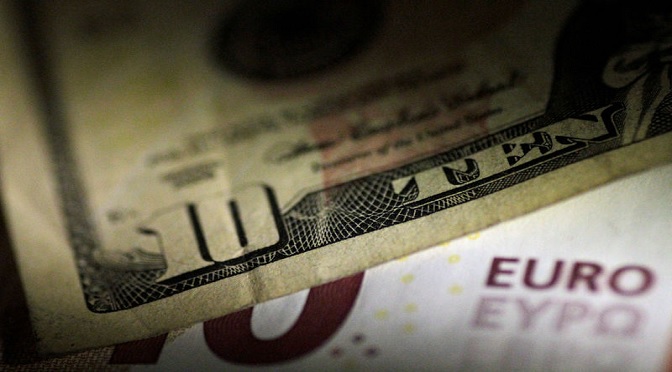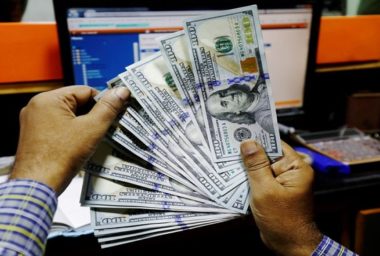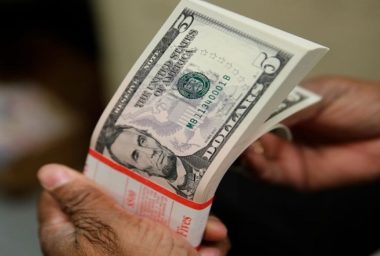-
Authoradmin
-
Comments0 Comments
-
Category
By Tom Finn
LONDON (Reuters) – The euro on Friday was headed for its biggest weekly rise in over four months with the dollar weakening on cautious signals from the Federal Reserve about further rate hikes.
The euro has been stuck in a $1.12-$1.15 range for the last three months due to growth fears and signs the European Central Bank is unlikely to end its stimulus soon.
But dovish Fed minutes this week have triggered dollar selling allowing the euro surge to as high as $1.1581 and propelling it past a 100-day moving average for the first time in three months.
“The euro remains supported by the soft dollar story. The risk of a short squeeze perhaps to the $1.1620/ area remains,” said Chris Turner, head of foreign exchange at ING in London.
He added, though, that a soft macro outlook suggests “Europe will struggle to attract rotational flows out of U.S. markets.”
Despite its recent gains the single currency has been pressured by a slew of weaker-than-expected economic data, especially from France and Germany.
The European Central Bank is widely expected to remain accommodative in 2019, which traders say should prevent the currency from breaking much higher.
Another possible reason for euro strength is a resurgence this week in the offshore Chinese yuan, said Kit Juckes, a currencies strategist at Societe Generale (PA:SOGN).
“A stronger yuan means that 23.6 percent of the euro’s trade-weighted basket is going up, and that means that even a currency weighed down by domestic economic and political woes can get a little lift against the dollar,” he said.
The yuan has breached the key 6.8 per dollar level in both onshore and offshore trade.
China and the United States have extended trade talks in Beijing, boosting oil prices and broader sentiment.
That has lifted the yuan to its highest level since late July along with recent assurances from Beijing of further fiscal boosts to the slowing economy.
U.S. Treasury Secretary Steven Mnuchin said late on Thursday that Chinese Vice Premier Liu He will “most likely” visit Washington later in January for trade talks.
Currencies such as the Australian dollar , a gauge of risk appetite, and the New Zealand dollar , are likely to see further gains if a U.S.-Sino trade deal is reached, said Sim Moh Siong, currency strategist at Bank of Singapore.
The dollar index (DXY) on Friday fell by 0.2 percent to 95.32. The index has fallen around 2.2 percent since mid-December on expectations that a slowdown in growth, both in the United States as well as globally, will restrict the Fed from raising rates in 2019.
Markets are now pricing in no further rate hikes by the Fed this year.
In 2018, the greenback outperformed its peers, gaining 4.3 percent as the Fed hiked rates four times on the back of a strong domestic economy.
Elsewhere, sterling traded marginally weaker, fetching $1.2737 with traders focused on the progress of Brexit.
British Prime Minister Theresa May must win a vote in parliament to get her Brexit deal approved or risk seeing Britain’s exit from the European Union descend into chaos. The vote is now due to take place on Jan. 15.
Recent Comments
- Starlight Herot on Euro Higher on German Data, Sterling Edges Lower
- Frost Dragont on Euro Higher on German Data, Sterling Edges Lower
- Gwinnettt on Euro Higher on German Data, Sterling Edges Lower
- Vanessat on Euro Higher on German Data, Sterling Edges Lower
- Christinet on Euro Higher on German Data, Sterling Edges Lower
Archives
- April 2025
- March 2025
- February 2025
- January 2025
- December 2024
- November 2024
- October 2024
- February 2024
- July 2023
- July 2021
- May 2021
- March 2021
- February 2021
- September 2020
- May 2020
- February 2020
- December 2019
- November 2019
- October 2019
- September 2019
- August 2019
- July 2019
- June 2019
- May 2019
- April 2019
- March 2019
- February 2019
- January 2019
- December 2018
- November 2018
- October 2018
- September 2018
- August 2018
- July 2018
- June 2018
- May 2018
- April 2018
- March 2018
- February 2018
- January 2018
- December 2017
- November 2017






